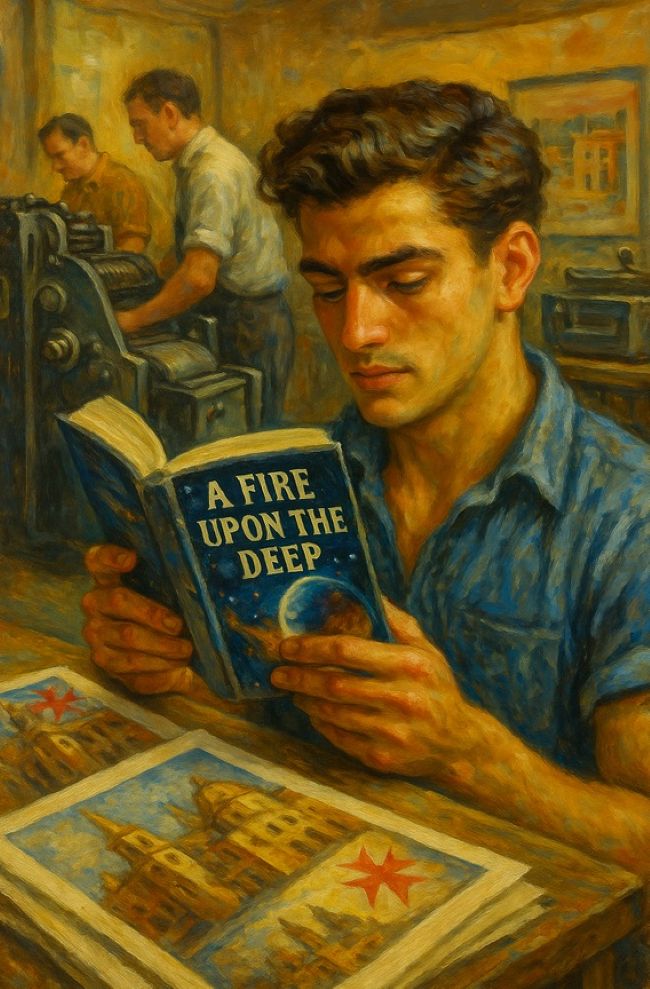| Malta Short Let: Cozy Stay in Gzira | |
|
Sliema Area Modern Designer Finished 2 Bedrooms + Games Room. First floor with Maltese Balcony Large back Terrace with swinging sofa Fully Airconditioned + Full Kitchen 3 TVs, including 65” with backlight. |
 |
|
Book Now: Google Travel | Direct (Cheapest) | Booking.com | Airbnb |
|
⌛ C&S (Consequences and Sequels): Thinking Through Time
Part 8 of the Maltese Mental Models series on Edward de Bono’s thinking tools
That year, Michael’s father, on a UK trip to buy more printing machines, bought him A Fire Upon the Deep by Vernor Vinge, a sci-fi novel about a galaxy-wide communication network. Reading it and sending his first email months later, Michael was hooked, sensing the internet’s potential to reshape the future. He welcomed the exclusion, seeing it as a chance to explore this new world. When he built a basic website to promote the printing business, his brothers dismissed it, insisting phones were their tool, as modems and ISPs were niche in 1995 Malta.
Yet Michael’s intuition—that software and the internet would dominate—led him to start an online business that employed them all by 2024.
This is C&S (Consequences and Sequels), Edward de Bono’s tool for deliberately looking ahead to see the future effects of a decision, beyond its immediate impact.
🌊 Why C&S Matters: Thinking Beyond the Present
Decisions often focus on the moment—today’s costs or benefits. But Edward de Bono emphasized that consequences don’t exist until you actively foresee them. Unlike CAF, which examines factors present now, C&S looks at what happens after a decision is made. Michael’s brothers saw excluding him as a way to maintain their steady business, not anticipating how his sci-fi-inspired vision of digital networks would create new opportunities. In 2025, with AI and global markets accelerating change, C&S is critical for anticipating how choices shape your future—whether in work, family, or society.
🔭 The C&S Framework: Mapping Michael’s Journey
De Bono’s C&S focuses on four time scales—immediate, short-term, medium-term, and long-term—to assess a decision’s impact. Michael intuitively applied this by envisioning a digital future after reading A Fire Upon the Deep and sending his first email. Here’s how his exclusion unfolded:
⌛ Consequences: The Immediate Ripples (1995)
The Decision: Keep 15-year-old Michael out of the family printing business.
Immediate Consequences:
- Michael, inspired by A Fire Upon the Deep’s galaxy-wide network, sends his first email, senses the internet’s potential, and enrolls in IT courses at MCAST. He builds a website to promote the printing business, but his brothers dismiss it, favoring phones as modems are niche.
- Brothers maintain current operations, avoiding added workload.
- Family finances stay stable, with minor tensions.
🌌 Sequels: The Future Unfolds
Sequels reveal longer-term effects across relative time scales. Michael’s intuitive foresight shaped his path:
| Time Period | What Unfolded | The Hidden Thread |
|---|---|---|
| 1998-2000 Short-Term |
Michael builds coding skills during the dot-com boom, creating a basic website to promote the printing business. Printing business faces competitors but holds steady. | Digital skills grow as print stabilizes. |
| 2001-2003 Short-Term |
Dot-com crash hits. Michael joins Malta’s gaming startups, learning business strategies, convinced software is key. | Exposure to innovative models. |
| 2004-2008 Medium-Term |
Printing profits flatten. Michael keeps gaining experience. His entrepreneur spirit strengthens by both his family business and looking at how gaming companies operate sensing the internet rise. | Groundwork for a digital venture. |
| 2009-2012 Medium-Term |
Michael launches an online webshop selling cleaning products. | Digital tools meet practical needs. |
| 2013-2015 Long-Term |
Online site grows popular as internet access spreads. Printing business closes as demand shifts. | Michael becomes the provider. |
| 2016-2024 Long-Term |
Michael hires his brothers to manage deliveries from Sicily and beyond and making deliveries to local buyers, sustaining the family. | Exclusion creates new opportunities. |
🧠 Understanding Cascade Types Through Michael’s Story
📈 The Amplifying Cascade
Michael’s vision of an interconnected world, before the internet was mainstream and establshed amplified each step:
- Exclusion led to IT studies after his first email hooked him.
- Studies led to a developer job.
- Job led to business networks.
- Networks led to an online venture despite skepticism.
- Venture led to family employment.
🔄 The Reversing Cascade
The brothers’ choice to preserve the business backfired:
- Preserving the print model missed digital opportunities.
- Excluding Michael ensured stability but limited innovation.
- Not taking a decision, is also a decision.
🌀 The Transforming Cascade
Michael’s intuitive foresight reshaped the family’s system:
- From a local print shop to an online business in a new niche.
- From separate roles to collaborative work.
- From stable but limited to new possibilities.
💡 The C&S Lessons Hidden in Plain Sight
What Michael’s Brothers Saw (Snapshot Thinking)
- Business supports three families adequately now.
- Michael is too young to contribute now.
- Maintaining current operations is safest now.
What C&S Thinking Would Have Revealed
| The Decision | Immediate Consequence | Long-term Sequel |
|---|---|---|
| Exclude Michael | Maintains current workload | Limits new ideas |
| Encourage school | Michael learns IT | Develops future-focused skills |
| Keep print model | Short-term stability | Misses digital shift |
De Bono’s key insight: A decision’s immediate appeal (stability) may hide long-term risks (stagnation) or benefits (innovation). Michael intuitively applied C&S, inspired by A Fire Upon the Deep’s galaxy-wide network and his first email, seeing exclusion as a chance to pursue a future where the internet would dominate.
🎯 Applying C&S to Your Decisions
De Bono’s C&S process, as Michael’s intuitive foresight shows, involves deliberate steps to foresee consequences and sequels:
⚠ C&S Pitfalls Michael’s Brothers Fell Into
| Their Mistake | What They Missed | The C&S Fix |
|---|---|---|
| Timeline Truncation | Saw only current finances | Project across all time scales |
| Linear Thinking | Exclusion = less work | Anticipate nonlinear outcomes |
| Single Path Fallacy | Print is our only model | Explore alternatives (see APC) |
| Reversal Blindness | Stability = security | Test when stability limits growth |
| Stakeholder Oversight | Ignored Michael’s potential impact | Assess consequences for all involved |
The brothers focused on immediate stability, missing how Michael’s exclusion could spark innovation. De Bono stressed that C&S prevents such oversights by forcing attention to the future, as Michael did intuitively by sensing the internet’s rise after reading A Fire Upon the Deep.
🎮 Practice Exercises: Developing Your C&S Vision
🌊 The C&S Transformation: Michael’s Wisdom
By 2024, Michael’s online business employs his brothers, who manage logistics, customer service, and operations. They share light moments at family dinners, noting how excluding Michael led to new opportunities.
Inspired by A Fire Upon the Deep’s galaxy-wide network, bought by his father in the UK, and his first email, Michael saw the internet’s potential in 1995, despite his brothers’ reliance on phones. The printing press, started with secondhand machines, evolved into an online venture, carrying forward their father’s legacy of building something practical.
Michael’s C&S Principles
📊 Summary: Your Time Telescope
| Tool: | C&S (Consequences and Sequels) |
| Purpose: | Anticipate a decision’s short- and long-term effects |
| Core Insight: | Immediate choices shape future outcomes |
| Key Question: | What happens next, and then what? |
| Michael’s Lesson: | Intuitive foresight can turn exclusion into opportunity |
| Remember: | Focus deliberately on the future |
🎯 Next Steps
Michael’s brothers focused on maintaining their steady printing business, dismissing his website as impractical. Michael’s vision, sparked by A Fire Upon the Deep, led him to explore new paths. In the next article, APC (Alternatives, Possibilities, Choices), you’ll learn to uncover multiple options, avoiding the trap of a single solution.
Try C&S on a decision today. Ask: What are the immediate risks and benefits? What happens in five or ten years? Like Michael’s intuitive leap, the answers might reveal a new direction.
Navigation: ← Previous: FIP (First Important Priorities) | Series Start | Next: APC (Alternatives, Possibilities, Choices) →
Part of the Maltese Mental Models series • Teaching Edward de Bono’s thinking tools for the AI age








